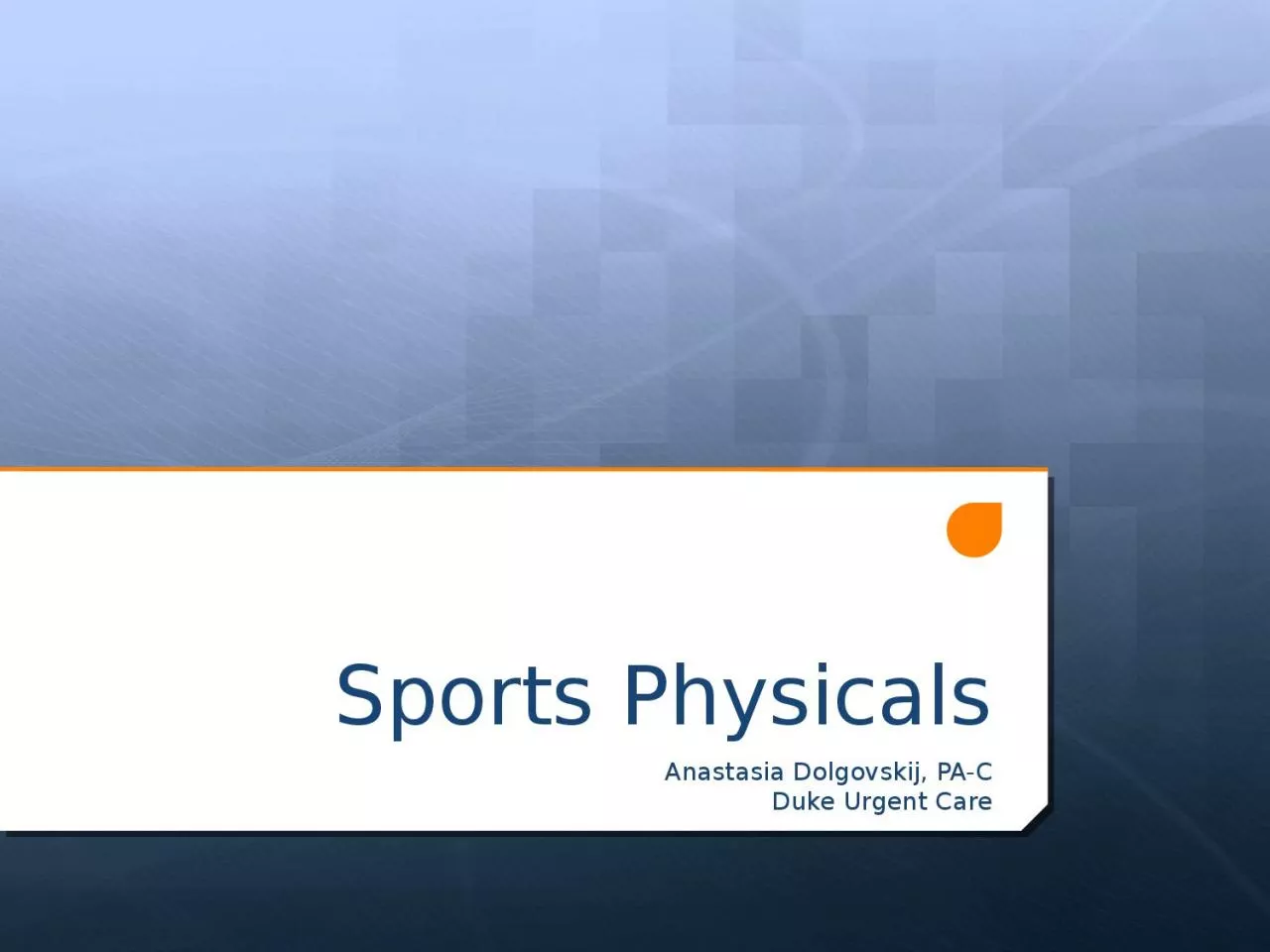

Duke Urgent Care Sports HS Athletes History Medical illnessinjury since last checkup Surgerieshospitalizations Prescription meds or supplements Allergies Foods meds insects seizure headaches ID: 1036006
Download Presentation The PPT/PDF document "Sports Physicals Anastasia Dolgovskij, P..." is the property of its rightful owner. Permission is granted to download and print the materials on this web site for personal, non-commercial use only, and to display it on your personal computer provided you do not modify the materials and that you retain all copyright notices contained in the materials. By downloading content from our website, you accept the terms of this agreement.
1. Sports PhysicalsAnastasia Dolgovskij, PA-CDuke Urgent Care
2. Sports!
3. HS Athletes
4. HistoryMedical illness/injury since last checkupSurgeries/hospitalizationsPrescription meds or supplementsAllergies Foods, meds, insects seizureheadaches
5. HistoryDuring or after exercisePassed outDizzyChest painHeart palpitationsFatigue easier than othersShortness of breath, wheezingHeart murmurNumbness/tingling
6. HistoryPrevious restrictions for sports?Eye problemsPrevious sprains, fracturesIllegal drug useHypertension, high cholesterolFamily member or relative sudden cardiac death before age 50?
7. HistoryHead injuriesConcussionLoss of consciousnessMemory loss
8. ExamVitalsHeight, weightBlood pressure, pulseVisual acuity AppearanceHeartLungsPulses
9. ExamMusculoskeletal NeckBackArmShoulder, elbow, forearm, wrist, handLegHip, knee, ankle, foot
10. Special ConsiderationsHypertrophic CardiomyopathyMutations in sarcomere genes encoding for contractile apparatus of heartSymptomsFatigue, dyspnea, chest pain, palpitations, presyncope/syncopeIncreased incidence of supraventricular and ventricular arrhythmiasIncreased risk for sudden cardiac death!Not progressive1% annual mortality rate
11. HCMPrevalence0.5% worldwide SymptomsNo or minor symptomsDiagnosed by family screening**heart murmur during exam**Abnormal ECGMost common clinical symptomsDyspnea, fatigue, chest pain, syncope, palpitationsGender specific: at presentationFemales sig older, more symptomatic
12. HCMExam May be normalNonspecific abnormalities4th heart sound, systolic murmur, LV liftSystolic murmursLVOT obstructionHarsh crescendo-decrescendo systolic murmurBegins slightly after S1Heard best at apex and lower left sternal borderMay radiate to axilla and baseNot into the neck!
13. HCMSystolic murmurs, contAbnormal mitral valve anatomyImpaired leaflet coaptation and MR(posterior directed jet)Heart sounds: mid-late systolic murmur at the apexExam maneuversAffect degree of LVOT obstruction and cause a change in intensity of crescendo-decrescendo murmurUpright posture from squatting/sitting Valsalva maneuverNitro administration Decrease in intensity (obstruction)Standing to sittingHandgripPassive elevation of legs
14. Valsalva Maneuver
15. HCMOther exam findings (non pathognomonic)First heart sound normal3rd/4th heart sound common in young patientsDiffuse, forceful LV apical impulseSystolic thrill at apex of LLSBECG findingsProminent abnormal Q waves (inferior and lateral leads)Septal depolarization of hypertrophied myopathic tissueLVH with right atrial enlargementSTRONGLY suggestive of HCMLADDeeply inverted T waves V2-V4 with apical variant of HCMIf suspect HCM, do NOT pass them! Refer to cardiology, or have them followup with pcp for further evaluation.
16. ConcussionsMild TBI Head injury due to contact &/or acceleration/deceleration forcesGCS 13-15, approx 30 min after injuryConcussion: more mild brain injuryTrauma-induced alteration in mental statusMay or may not have LOC1.74 million TBI in USA/yearMVA, falls, WC, recreational accidents, assaultsSports related: 1.6-3.8 million/yr in USAmerican football, hockey, soccer, boxing, rugby
17. Glasgow Coma Scale
18. ConcussionSigns/symptomsHallmark symptoms are confusion and amnesiaWith OR without LOCImmediately or several min laterHA, dizziness, nausea, vomiting, lack of awareness of surroundings.Min to hours Mood/cognitive/sleep disturbances (hours/days)Exam findingsVacant stare, delayed verbal expression, inability to focus, disorientation, abnormal speech, emotional instability, memory deficitsPost traumatic seizures1st week after head injury. Acute symptomatic events-NOT epilepsy<5% of mild/moderate TBIMore common with severe TBI
19. ConcussionNeurologic deterioration after mild TBI is highly suggestive of an evolving intracranial hematomaSubdural hemorrhage: tearing in bridging veins or dura.Acute, subacute, chronicEpidural hemorrhageArterial; acute, abrupt presentationMight be delayed (20-50% lucid interval)Injuries to other parts of head/neck. Canadian Head CT RuleStandardized assessmentsStandardized Assessment of Concussion
20. ConcussionSequelaeSecond impact syndromeDiffuse cerebral swelling-rare but fatalAfter a 2nd concussion, while still symptomatic from 1st onePostconcussion syndromeHA, dizziness, neuropsych symptoms, cognitive impairmentFew weeks-few monthsPost-traumatic HAWithin 7 days of injury (HIS criteria)Nonspecific and may be indistinguishable from other HA syndromesPost-traumatic epilepsy2x increased risk of epilepsy for 1st 5 years after injury
21. ConcussionSequelae, contPost-traumatic vertigoSubstantial contributor to disability after mild TBIOther Anosmia, hyposmiaDiplopiaFacial pain/occipital neuralgiaCTE
22. ConcussionReturn to PlayCurrent guidelines are consensus based rather than evidence basedPremature return to play-greater risk for subsequent injury!!Higher # of concussions, greater risk of future concussionsSuspect concussion:Removed from play and evaluated by a health professional. ER for LOCConcussion: removed from play until symptom resolutionMultiple concussions: more detailed eval. Sports PEh/o concussion and symptoms-do NOT pass! Refer to neuro or pcp followup with further evaluationConcussion clinics